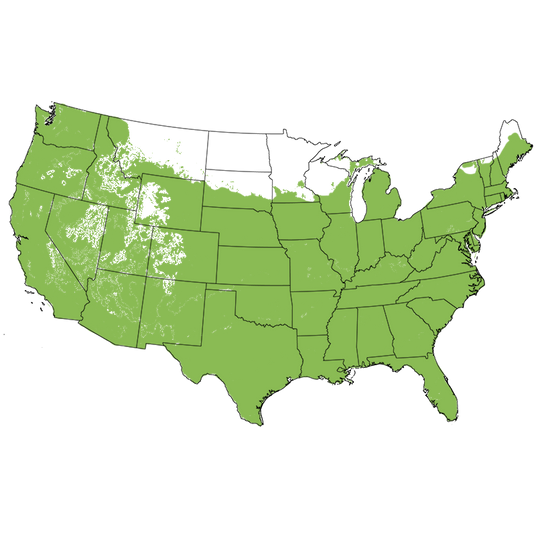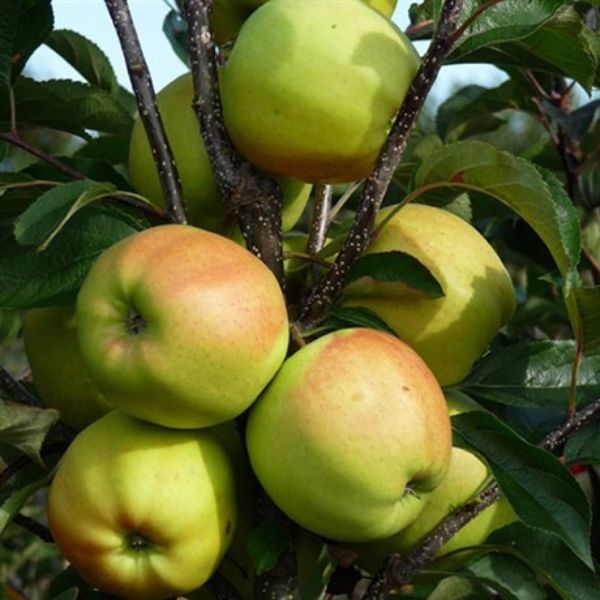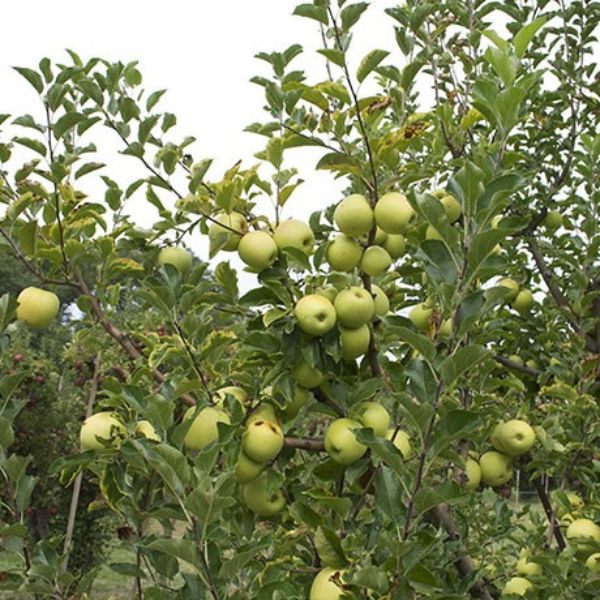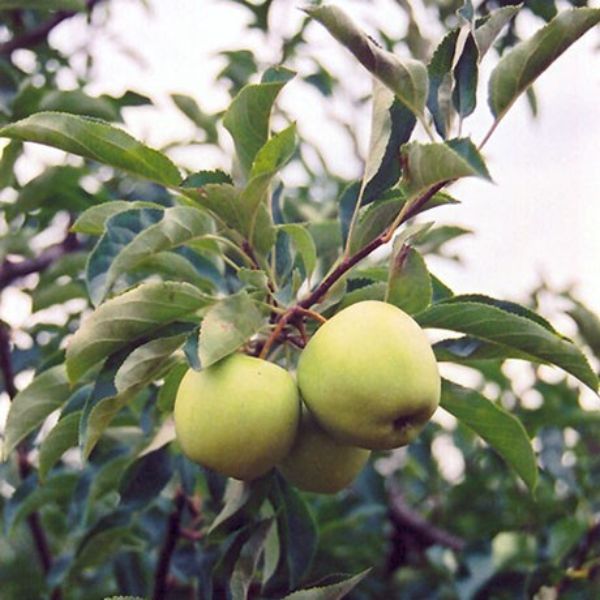Golden Delicious Apple Tree
Malus 'Golden Delicious'
Plant Sentry™
Plant Sentry™

Plant Sentry™ Protected
Your order is protected by our compliance system that:
- Prevents restricted plants from shipping to your state
- Ensures plants meet your state's agricultural requirements
- Protects gardens from invasive pests and diseases
Delivery and Shipping
Delivery and Shipping
Delivery and Shipping
Fast, Safe Plant Delivery
Ships in 3-4 business days • Tracking provided • Weather protected
| Under $50 | $9.99 |
| $50 - $99.99 | $14.99 |
| $100 - $149.99 | $16.99 |
| $150 - $198.99 | $24.99 |
| $199+ | FREE |
✓ Zone-specific timing • ✓ Professional packaging • ✓ Health guarantee
Understanding Plant Options
Nature Hills offers plants in two main formats:
- Container Plants: Grown in pots with soil, sized by container volume and plant age
- Bare Root Plants: Dormant plants without soil, sized by height measurements
Container Plant Sizes
Container sizes indicate plant age and growing capacity rather than liquid volume equivalents. Our containers follow industry-standard nursery "trade gallon" specifications, which differ from standard liquid gallon measurements.
Young Plants (6 months to 18 months old)
| Container Size | Actual Volume | Metric Equivalent |
|---|---|---|
| 2" x 2" x 3" | 0.18 - 0.21 dry quarts | 0.20 - 0.23 dry liters |
| 4" Container | 0.31 - 0.87 dry quarts | 0.35 - 0.96 dry liters |
| 4.5" Container | 0.65 dry quarts | 0.72 dry liters |
| 6" Container | 1.4 dry quarts | 1.59 dry liters |
| 1 Quart | 1 dry quart | 1.1 dry liters |
| 5.5" Container | 1.89 dry quarts | 2.08 dry liters |
Established Plants (18 months to 2.5 years old)
| Container Size | Actual Volume | Metric Equivalent |
|---|---|---|
| 2 Quart | 2 dry quarts | 2.2 dry liters |
| #1 Container | 2.26 - 3.73 dry quarts | 2.49 - 4.11 dry liters |
| 5" x 5" x 12" | 3.5 - 4.3 dry quarts | 3.85 - 4.74 dry liters |
Mature Plants (2-4 years old)
| Container Size | Actual Volume | Metric Equivalent |
|---|---|---|
| #2 Container | 1.19 - 1.76 dry gallons | 5.24 - 7.75 dry liters |
| #3 Container | 2.15 - 2.76 dry gallons | 8.14 - 12.16 dry liters |
Large Plants (3-5 years old)
| Container Size | Actual Volume | Metric Equivalent |
|---|---|---|
| #5 Container | 2.92 - 4.62 dry gallons | 12.86 - 20.35 dry liters |
| #6 Container | 5.25 - 6.01 dry gallons | 23.12 - 26.42 dry liters |
| #7 Container | 5.98 - 6.53 dry gallons | 26.34 - 28.76 dry liters |
Bare Root Plants
Bare root plants are sold by height from the root system to the top of the plant. Plants may exceed minimum height requirements.
Common Sizes:
- Trees: 1 foot, 2 feet, 3 feet, 4 feet, 5 feet, 6 feet
- Shrubs & Perennials: 1 foot, 18 inches, 2 feet
Important Notes
Container Volume Specifications
- Trade Gallon Standard: Our containers follow industry-standard "trade gallon" specifications established by the American National Standards Institute (ANSI Z60.1) for nursery stock
- Volume Variations: Actual soil volume may vary due to plant root systems and growing medium settlement
- Age Indicators: Container size primarily indicates plant age and maturity rather than liquid volume equivalents
Growing Conditions
- Plant size can vary based on variety and growing conditions
- Container size helps indicate plant maturity and establishment level
- Larger containers generally mean more established root systems and faster landscape establishment
Seasonal Availability
- Bare root plants are available seasonally when dormant
- Container plants are available throughout the growing season
- Specific varieties may have limited availability in certain sizes
Questions?
For questions about specific plant sizes or availability, please contact our plant experts who can help you choose the right size for your landscape needs.

Plant Sentry™ Protected
Your order is protected by our compliance system that:
- Prevents restricted plants from shipping to your state
- Ensures plants meet your state's agricultural requirements
- Protects gardens from invasive pests and diseases
Plant Profile & Growing Essentials
Cold hardy, Edible, Self-pollinating, Ornamental Berries/Fruit, Flowering, Thornless, and Attracts pollinators
Specifications
Specifications
-
Botanical Name
-
Height
-
Width
-
Growing Zones
-
Sunlight
-
Growth RateModerate
-
Flower Color
-
Leaf Color
-
Fall Color
-
Pollinator FriendlyYes
-
Pollinator Required
-
Bloom PeriodLate Spring
Planting & Care Instructions
Planting & Care Instructions

Growing Zones 5-10
Order the wildly popular, and easy-to-grow Golden Delicious Apple Tree! Golden gems of crispy goodness! The Golden Delicious Apple tree (Malus 'Golden Delicious') is one of the world's most widely planted Apple trees and is one of the easiest and most dependable Apple trees to grow!
The Golden Delicious Apple tree (Malus 'Golden Delicious') has vigorous growth and high fruit production! The spring show of rosy pink buds that burst open into fragrant white blooms is fantastic. Pollinators, beneficial insects, and butterflies flock to this explosion of white blossoms.
Then the lush green leaves take the stage until fall and then the real show you've been waiting for begins! From September to October, your Golden Delicious Apples will turn from a pale green to their familiar golden-green color, signaling that they are ripe in mid-September.
Allowed to ripen on the tree, you will notice a vast difference in flavor when compared to the Golden Delicious Apples purchased at the supermarket. And there's nothing quite like a fresh-picked piece of fruit you grew yourself! These crisp and juicy Apples are delightful!
Homegrown Golden Delicious Apples are exceptionally sweet and rich. Their thin skin and delicious crisp fruit make the Golden Delicious a favorite for eating fresh off the tree and for baking. Perfect in salads and complements savory dishes great! Canning and preserves taste divine and tasty Applesauce! Pack a few in lunch boxes and for healthy snacks high in vitamins and antioxidants!
Choose between standard and semi-dwarf sizes depending on your space available, however, Apple trees don't mind some summer pruning to further control their size! Hardy throughout a wide range of USDA planting zones 5 through 10, the space-saving size of these trees makes them as beautiful in the front yard garden as they are for small orchards and home gardens!
This comes in handy when planting Golden Delicious Apples with one of their pollinator partners for increased harvests! Good storage Apples, Golden Delicious will keep for 3-4 months in cool storage and refrigeration.
Planting and Application:
Shade your patio with beautiful shade or lounge beneath the lush foliage in your favorite hammock. Just sit back and watch the busy bees and butterflies that will flock to the floral show! Dual-purpose edible landscaping and shading your vegetable garden and other plantings.
Cottage gardens are perfect locations where their blooms help welcome spring to the landscape. The spring flush of flowers makes this garden delights an ideal front lawn tree specimen or a beautiful way to anchor a garden path or reading nook! Be sure to plant one where you can view the glorious display in spring and watch your harvest grow!
Golden Delicious is easy to grow, and produces large, high-quality, all-purpose Apples with heavy annual crops, making it a great choice for you and your family.
For the best crop, pair a pollinator partner tree with Golden Delicious like a white-flowering Crabapple or a Cox's Orange Pippin, Empire, Freedom, Frostbite, Fuji, Haralson, Honeycrisp, Jonathan, Northland, Red Delicious, SnowSweet, Wealthy, or WineCrisp Apple!
Pair this mid-late season Apple with an early-ripening variety and a late-season storing Apple tree variety like Granny Smith for months of backyard goodness! It is also an excellent pollinator for most other Apple trees that ripen from September to October.
- Glowing Green Skin Ripens to Golden Yellow & Red Blush
- Thin Skin is Sweet & Rich With Crisp White Flesh
- Pink Buds & Showy, Fragrant White Flowers
- Healthy, Delicious & Easy to Grow!
- Fresh Eating & Baking Apple
- Partially Self-Pollinating - Ripen in September
- Prolific & Vigorous Growth
- Dependable Annual High Yield & Productive Crop
- Pollinated by Red Delicious, Honeycrisp & Red Jonathan for Larger Crops
#ProPlantTips for Care:
These hardy fruit trees are more heat-hardy than most Apple trees! They're also cold-tolerant and widely adaptable! Golden Delicious Apple trees are partially self-pollinating, which means they can be grown without another tree, but for the largest crops, plant a pollination partner in your garden. Try high-density planting techniques when space is limited.
Fruit trees require full sun and well-drained soil. Not tolerating excess water or poor drainage, they cannot grow well in soggy soil. Plant Apple Trees in rich, organically amended well-drained soil, with a good layer of arborist mulch over the root system's surface to further hold in moisture and insulate the roots from heat and cold. Also requiring consistent waterings, especially during summer for higher yields, it's best to protect your investment with a regular watering schedule!
Because it's such a prolific tree, part of the Golden Delicious Apple tree care is to be sure to thin out the fruit in the spring. Branches can break under the weight of all that beautiful fruit. Pruning is best done in late winter when the tree is dormant. Prune Apple Trees to keep an open canopy that allows plenty of sunshine and air circulation. In the summer, prune away water growth and suckers, and prune to control the growth/size of your tree.
More disease-resistant and powdery mildew-resistant than most Apple cultivars. For best results, check out our Fruit Tree fertilizer section, and don't forget the Nature Hills Root Booster for a fast and successful establishment!
- Full Sun For The Most Fruit & Best Health
- Enriched Well-Drained Soil
- Regular Moisture Access
- Appreciates Mulched Beds
- Disease & Powdery Mildew Resistant
- ~600-700 Chill Hours
Discovered in West Virginia, this is a fantastically adaptable fruit tree! All-purpose eating and baking, the Golden Delicious Apple tree is a fantastic addition to your home's landscaping and orchard! Order this adaptable and resistant tree from NatureHills.com today before they're gone!
Golden Delicious Apple Tree Frequently Asked Questions
When to Plant Golden Delicious Apple Trees
Planting Bareroot trees as soon as you can dig a hole in spring and until hot weather, the earlier the better. Plant container Apple trees throughout the growing season with complete success - that is the benefit of container plants - to extend the planting season. Your County Agricultural Extension Office is a great resource for first and last frost dates in your area.
How to Plant Golden Delicious Apple Trees
Dig a large hole only as deep as needed to accommodate the bareroot or container root ball, and twice as wide. Remove the pot or bag and situate it into the hole so the top of the soil (soil line if bareroot), is level with the new location's soil being careful not to plant too deep. Water in again very well and backfill with the same soil you dug up, tamping down gently to ensure there are no air pockets.
Top off with a 3-4 inch thick layer of Arborist mulch. Consider staking your tree to keep its trunk growing straight for the first year to ensure it stands tall against strong winds and drifting snow.
When to Prune Golden Delicious Apple Trees
Trim off any broken branches from delivery as soon as you take them out of the box. Prune and trim Apple trees while dormant, in late winter or early spring, before you see new growth.
How to Prune Golden Delicious Apple Trees
Dormant prune to:
- Remove any double leaders or narrow crotch angles
- Eliminate any crossing branches
- Thin interior branching and leave the fruiting spurs and strong branches in place opening up the canopy
- Branching at least 24-36 inches above the ground
Prune Apple trees in the summer to:
- Control size and shape by reducing the length of longer new growth on vigorous trees
- Remove water sprouts on the main trunk or older branches in the crown
- Remove suckers at the base of the trunk
- Thin fruit during heavy years on established trees
How to Care for Golden Delicious Apple Trees
Growing an Apple tree is easy when proper soil, good drainage, attention to moisture, and regular fertility are maintained. Once you've chosen an Apple tree that works for your climate, in the size you need for your landscape, and its pollinator (if needed), then you've accomplished half the battle!
- Apple trees do best in full sun and well-drained soil
- Water your apple trees when they get dry - especially during the fruit production stage, and drought periods to keep them stress-free
- Use arborists' wood chips to mulch over the roots of your apples and have your soil tested to see what your soil may be lacking before adding fertilizers
- Maintenance pruning and shaping
Apple trees will tolerate a wide range of soils, so long as water and nutrients are not limited and the pH level is adequate.
How to Fertilize Golden Delicious Apple Trees
For the first year, water alone is most important. It is always best to get a soil test to see what your soil is lacking before adding more fertilizers. Once established, a fertilizer routine may be beneficial. We do offer some excellent slow-release organic options, applied according to the package directions.
Fruit trees need more phosphate and it's possible to apply too much nitrogen which affects the soil's pH. Test soil acidity or alkalinity using a pH Tester.
Fertilize in spring when you first see new growth emerging.
- Don't overdo it
- Phosphates are your friends
- Pay attention to pH in areas with extremely high or low soil pH
- Follow the directions
Golden Delicious Apple Tree Pollinating Info
The Golden Delicious is partially self-pollinating, but for a far larger harvest, plant it with one of these popular partner trees. Golden Delicious is self-fruiting and doesn't need a pollinating partner, but will bear more fruit when paired with these varieties:
- Centennial, Chestnut & Northland Crabapple Trees
- Cox's Orange Pippin
- CrimsonCrisp
- Empire
- Freedom
- Frostbite
- Fuji
- Granny Smith
- Haralson
- Honeycrisp
- Jonathan
- Red Delicious
- SnowSweet
- Wealthy
- WineCrisp
Harvest Times for Golden Delicious Apple Trees
Golden Delicious's are typically ready to harvest in September. Early-Season? Mid-Season? Late-Season? The terminology can be confusing for new Apple tree growers. Weather, climate, and your tree determine when it's ripe.
For Apples:
- Early-season is usually June-July
- Mid-season can be August-September
- Late-season can be from late September-November
The growing season consists of spring, summer, and fall, and varies with climate and weather. Areas with longer growing seasons in the warmer hardiness zones can greatly affect the harvest times for each particular Apple variety grown in your area. Learn which growing zone you are in.
Rootstocks Explained
Apple trees have been grafted onto different rootstocks since before the mid-1800s. Different rootstocks are used to improve the anchoring of trees, eliminate diseases, and reduce the natural mature size of the tree itself. While there are many different types of rootstock, they are all labeled as being either Dwarf, Semi-Dwarf, or Standard.
The Apple descriptions, including flowering, pollination, and Apple characteristics are the same whether the plant is grown on a standard rootstock or some varying dwarfing rootstock. The overall size can vary by climate and soil but the understock used is ultimately what affects the mature size.
There will be some variation in sizes but as a guide, we are suggesting the overall mature size of these Apple varieties are:
Semi-Dwarf Apples
- Height: 12-18 feet
- Spread: 10 - 15 feet
Standard Apples
- Height 18 - 25 feet
- Spread: 15 - 18 feet
Remember that all fruit tree sizes can easily be altered if needed by simple pruning as the trees grow and develop.
What Shipping Options Do You Offer?
NatureHills.com works closely with our growers and nursery professionals to ensure we ship when it is most appropriate for your area. Our goal is to deliver the hardiest plants by avoiding extreme high and low temperatures. Check out our shipping schedule for more information and to learn our wills and won'ts when it comes to shipping plants. Find your Golden Delicious Apple Tree for sale here at NatureHills.com!












